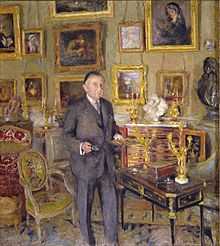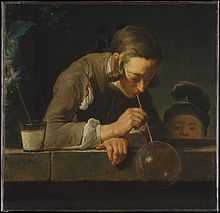David David-Weill
| David David-Weill | |
|---|---|
 Édouard Vuillard, David David-Weill, 1925. Oil on canvas. The Jewish Museum. | |
| Born | 1871 |
| Died | 1952 |
| Nationality | American |
| Ethnicity | Jewish |
| Occupation | Banker |
| Known for | Art collector |


David David-Weill (1871-1952) was a French-American banker, chairman of Lazard Frères in Paris, who built an important collection of art. His collection was plundered by the Nazis during the Second World War and over 2000 items seized. He was a major donor to French and American museums and galleries and a benefactor to universities.
Early life and family
David-Weill was born in San Francisco on 30 August 1871.[4] He was the son of Alexandre Weill (1834-1906), one of three French brothers who founded Lazard Frères & Co., and Julie Cahn. His parents had left France in 1870 because of the Franco-Prussian War and settled in California, where Raphael Weill, a brother of Alexandre Weill lived. They returned to France about 1883. David-Weill continued his education there at the Lycée Condorcet and the École Libre des Sciences Politiques. He married Flora Raphael in 1897 and they had seven children, including Pierre David-Weill and Jean David-Weill.
Banking career
Following his education, David-Weill performed his military service and began to work at Lazard Frères, where he rose to become chairman. He became regent of the Banque de France in 1935.
Collecting
David-Weill began to collect from an early age. His acquisitions included paintings, drawings, miniatures, sculpture, furniture, silverware and other items. He became president of the council of French national museums and vice president of the Friends of the Louvre.[4]
His collection was looted by the Nazis during the Second World War and, according to German records, 2687 items seized.[5]
In later life he donated more than 2000 items to museums and galleries, including the Guimet Museum, the Louvre, and universities at New York, Hamburg, Leiden, Honolulu, and Stockholm. He donated to the libraries of the Museum of Man and the National Institute of Art History, to which he gave the manuscript and journal of Eugène Delacroix. He gave his Chinese bronzes to the Musée Guimet, and his cloisonné objects to the Musée des Arts Décoratifs.[4]
Death
David-Weill died in Neuilly-sur-Seine on 7 July 1952.[4] Parts of his collection were sold in a series of auctions in 1970.
Honours
- David-Weill was elected to the Académie des beaux-arts in 1934.
- Avenue David-Weill in the 14th arrondissement of Paris was named in his honour in 1960 in tribute to his involvement with the Cité internationale universitaire de Paris.
See also
References
- ↑ Soap Bubbles. Metropolitan Museum of Art. Retrieved 16 February 2015.
- ↑ Sale 7701, Lot. 19. Christie's. Retrieved 16 February 2015.
- ↑ "Monet oil tests art market." Mark Brown, The Guardian, 5 February 2009. Retrieved 16 February 2015.
- ↑ 4.0 4.1 4.2 4.3 David David-Weill. Dumbarton Oaks. Retrieved 10 February 2015.
- ↑ Harclerode, Peter, & Brendan Pittaway. (1999) The Lost Masters: The Looting of Europe's Treasurehouses. London: Victor Gollancz, p. 44. ISBN 0575052546
Further reading
- Henriot, Gabriel. (1926) Collection David-Weill. Paris: Presses de Braun. (3 vols.)
External links
| Wikimedia Commons has media related to David David-Weill. |
- http://www.genea-bdf.org/BasesDonnees/genealogies/weill.htm
- http://www.frick.org/interact/video/fora/david-weill_family
- http://www.ciup.fr/bio-saison-1/david-david-weill-43536/
- http://lesassos.com/sn/article.php?article_id=499
- http://www1.alliancefr.com/culture/le-role-du-banquier-david-david-weill-dans-lart-5018242